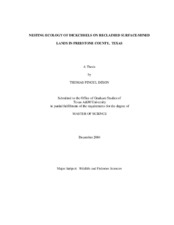| dc.description.abstract | Surface mining and subsequent reclamation often results in the establishment of large areas of grassland that can benefit wildlife. Grasslands have declined substantially over the last 150 years, resulting in declines of many grassland birds. The dickcissel (Spiza americana), a neotropical migrant, is one such bird whose numbers have declined in the last 30 years due to habitat loss, increased nest predation and parasitism, and over harvest (lethally controlled as an agricultural pest on its wintering range in Central and South America). Reclaimed surface-mined lands have been documented to provide important breeding habitat for dickcissels in the United States, emphasizing the importance of reclamation efforts. Objectives were to understand specific aspects of dickcissel nesting ecology (i.e., nest-site selection, nest success, and nest parasitism, and identification of nest predators) on 2 spatial scales on TXU Energy’s Big Brown Mine, near Fairfield, Texas, and to subsequently provide TXU Energy with recommendations to improve reclaimed areas as breeding habitat for dickcissels. I examined the influence of nest-site vegetation characteristics and the effects of field-level spatial factors on dickcissel nesting ecology on 2 sites reclaimed as wildlife habitat. Additionally, I developed a novel technique to identify predators at active nests during the 2003 field season. During 2002–2003, 119 nests were monitored. On smaller spatial scales, dickcissels were likely to select nest-sites with low vegetation, high densities of bunchgrasses and tall forbs, and areas with higher clover content. Probability of nest success increased with nest heights and vegetation heights above the nest, characteristics associated with woody nesting substrates. Woody nesting substrates were selected and bunchgrasses were avoided. Oak (Quercus spp.) saplings remained an important nesting substrate throughout the breeding season. On a larger scale, nest-site selection was likely to occur farther from wooded riparian areas and closer to recently-reclaimed areas. Nest parasitism was likely to occur near roads and wooded riparian areas. Results suggest reclaimed areas could be improved by planting more bunchgrasses, tall forbs (e.g., curly-cup gumweed [Grindelia squarrosa] and sunflower [Helianthus spp.]), clover (Trifolium spp.), and oaks (a preferred nesting substrate associated with higher survival rates). Larger-scale analysis suggests that larger tracts of wildlife areas should be created with wooded riparian areas comprising a minimal portion of a field’s edge. | en |


